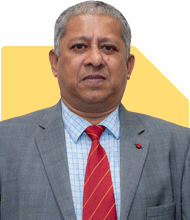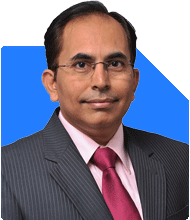Ramalingam Kalirajan |8098 Answers |Ask -Follow
Mutual Funds, Financial Planning Expert - Answered on Jun 06, 2024
He has an MBA in finance from the University of Madras and is a certified financial planner.
He is the director and chief financial planner at Holistic Investment, a Chennai-based firm that offers financial planning and wealth management advice.... more

I am 64. Have a nominal pension being in private service and have some investments worth about a couple of crores. I need a steady income of Rs 1 lakh every month. Kindly let me know how much lump sum I should invest & where with the option of possible capital appreciation. Thanks in advance.
Let's explore a comprehensive approach to meeting your financial needs.
Understanding Your Financial Needs
At 64, your primary goal is to ensure a steady monthly income of Rs 1 lakh. Given your nominal pension, supplementing this with a reliable investment strategy is essential. You also have a substantial investment corpus worth about a couple of crores, which provides a solid foundation.
Evaluating Your Current Financial Position
Before diving into investment strategies, let's assess your existing investments. If you hold any insurance-cum-investment policies like LIC or ULIP, consider their performance and potential. Such policies often combine life insurance with investment, leading to lower returns due to high fees and charges. Surrendering these policies and reinvesting the proceeds into mutual funds might be more beneficial.
Investment Strategy: Systematic Withdrawal Plan (SWP)
A Systematic Withdrawal Plan (SWP) is a viable strategy for generating regular income from your investments. SWP allows you to withdraw a fixed amount from your mutual fund investments at regular intervals, providing a steady income stream. This approach not only ensures regular income but also keeps your principal investment intact to some extent, offering potential capital appreciation.
Benefits of SWP
Regular Income: SWP provides a predictable and steady stream of income, which is crucial for managing your monthly expenses in retirement. This ensures that you receive a consistent amount each month without worrying about market fluctuations.
Capital Preservation: By systematically withdrawing only a portion of your investment, you help preserve your capital. This allows the remaining investment to continue growing, potentially increasing your wealth over time.
Flexibility: SWPs offer flexibility in terms of withdrawal amounts and frequency. You can adjust the withdrawal amount based on your needs and financial situation, ensuring that you have control over your income flow.
Tax Efficiency: SWP withdrawals can be tax-efficient as each withdrawal consists of both capital and gains. This can help in reducing the overall tax liability compared to other forms of income. The longer you hold your investments, the more tax-efficient they become.
Calculating the Required Lump Sum
To determine the lump sum required to generate Rs 1 lakh per month through SWP, we need to consider an average annual return. Assuming an annual return of 8%, you would need a substantial amount to support this withdrawal rate. Given the variability of market returns, it's crucial to plan conservatively to ensure the sustainability of your withdrawals.
Based on the target monthly income and the anticipated return, your existing investment corpus of about two crores appears sufficient. However, a more detailed calculation and projection with the help of a Certified Financial Planner (CFP) would ensure precision and confidence in your strategy.
Benefits of Actively Managed Funds
Investing in actively managed funds through a Certified Financial Planner (CFP) can offer numerous advantages. Actively managed funds are managed by professional fund managers who make investment decisions based on market analysis and trends. These funds aim to outperform the market, providing higher returns compared to index funds.
Disadvantages of Index Funds
Index funds, which passively track a market index, often have lower returns compared to actively managed funds. They lack the flexibility to respond to market changes and opportunities, which can limit potential gains. The absence of active management means index funds might miss out on profitable investment opportunities that fund managers could capitalize on.
Regular vs. Direct Mutual Funds
When considering mutual funds, opting for regular funds through a CFP is advisable over direct funds. Regular funds provide access to professional advice and guidance, ensuring your investments align with your financial goals and risk tolerance. Direct funds, while having lower expense ratios, lack this personalized advice, which can be crucial in managing your portfolio effectively.
Diversification for Risk Management
Diversifying your investment portfolio is crucial to managing risk and ensuring steady returns. Consider allocating your investments across various asset classes, such as equity, debt, and hybrid funds.
Equity Funds: These funds invest in stocks and offer potential for high returns. While they are riskier, their long-term growth potential can contribute to capital appreciation. Given your need for capital appreciation along with income, a portion of your portfolio should be allocated to equity funds. These funds, managed by experts, aim to outperform the market, providing better returns over time.
Debt Funds: These funds invest in fixed-income securities like bonds and are relatively safer. They provide regular income with lower risk, ensuring stability in your portfolio. Debt funds can offer more predictable returns and help in balancing the overall risk in your portfolio.
Hybrid Funds: These funds combine both equity and debt investments, offering a balanced approach. They provide growth potential while managing risk, making them suitable for steady income and capital appreciation. Hybrid funds can be an excellent choice for retirees, as they offer the best of both worlds—potential for growth and stability.
Tax Efficiency
When planning your investments, consider the tax implications of different investment options. Mutual funds offer tax benefits, especially long-term capital gains, which are taxed at a lower rate compared to other income sources. SWPs from mutual funds can be structured to minimize tax liability, as each withdrawal consists of both capital and gains, reducing the overall tax burden.
Emergency Fund and Contingency Planning
Ensure you have an emergency fund equivalent to at least 6-12 months of your monthly expenses. This fund should be easily accessible and kept in a liquid investment option like a savings account or liquid mutual fund. Having an emergency fund provides a safety net for unexpected expenses without disrupting your main investment strategy. This is a crucial aspect of retirement planning, as it ensures that you can handle unforeseen financial needs without affecting your long-term investments.
Reviewing and Rebalancing Your Portfolio
Regularly reviewing and rebalancing your investment portfolio is crucial to maintaining its alignment with your financial goals. Market conditions and personal circumstances can change, necessitating adjustments to your portfolio. A CFP can help you monitor your investments and make necessary changes to optimize returns and manage risk. Regular portfolio reviews ensure that your investments remain aligned with your risk tolerance and financial objectives, adapting to any changes in the market or your personal situation.
Role of a Certified Financial Planner
A Certified Financial Planner (CFP) can provide valuable insights and guidance in managing your investments. They can help you create a customized financial plan, considering your income needs, risk tolerance, and long-term goals. A CFP's expertise ensures that your investment strategy is well-balanced and aligned with your financial objectives. Their professional advice can help you navigate complex financial decisions, ensuring that you make informed choices to secure your financial future.
You have done an excellent job accumulating a substantial corpus. This provides a solid foundation for a comfortable retirement. Your commitment to ensuring a steady income in retirement is commendable. It's normal to seek guidance in managing your finances, and taking proactive steps shows your dedication to financial well-being.
Continuous Learning and Adaptation
Financial planning is a dynamic process that requires continuous learning and adaptation. Stay informed about market trends and investment opportunities. Regularly engage with your CFP to discuss any changes in your financial situation or goals. Adapting to new information and market conditions is key to successful financial management.
Conclusion
Achieving a steady income of Rs 1 lakh per month in retirement requires a well-thought-out investment strategy. Utilizing a Systematic Withdrawal Plan (SWP) with a diversified portfolio of mutual funds can provide the necessary income while ensuring potential capital appreciation. Opting for actively managed funds through a Certified Financial Planner offers the advantage of professional guidance and higher returns compared to index funds. Regularly reviewing and rebalancing your portfolio, along with maintaining an emergency fund, are essential steps in securing your financial future.
Your commitment to financial planning and securing a comfortable retirement is commendable. By following a strategic investment approach, you can achieve your financial goals and enjoy a worry-free retirement. Always remember to seek professional advice and continuously adapt your strategy to changing circumstances.
Best Regards,
K. Ramalingam, MBA, CFP,
Chief Financial Planner,
www.holisticinvestment.in
Let's embark on this financial journey together.
You can reach me through my website mentioned below.
This platform has restrictions on sharing personal contact. Hope you understand.
Best Regards,
K. Ramalingam, MBA, CFP,
Chief Financial Planner,
www.holisticinvestment.in
You may like to see similar questions and answers below
Ramalingam Kalirajan |8098 Answers |Ask -Follow
Mutual Funds, Financial Planning Expert - Answered on Apr 23, 2024
Sanjeev Govila |458 Answers |Ask -Follow
Financial Planner - Answered on Jan 22, 2024
Sunil Lala | Answer |Ask -Follow
Financial Planner - Answered on Feb 11, 2024
Ramalingam Kalirajan |8098 Answers |Ask -Follow
Mutual Funds, Financial Planning Expert - Answered on Apr 01, 2024
Prof Suvasish Mukhopadhyay |504 Answers |Ask -Follow
Career Counsellor - Answered on Mar 14, 2025
Radheshyam Zanwar |1417 Answers |Ask -Follow
MHT-CET, IIT-JEE, NEET-UG Expert - Answered on Mar 14, 2025
Prof Suvasish Mukhopadhyay |504 Answers |Ask -Follow
Career Counsellor - Answered on Mar 14, 2025
Prof Suvasish Mukhopadhyay |504 Answers |Ask -Follow
Career Counsellor - Answered on Mar 14, 2025
Ravi Mittal |546 Answers |Ask -Follow
Dating, Relationships Expert - Answered on Mar 13, 2025
Janak Patel |21 Answers |Ask -Follow
MF, PF Expert - Answered on Mar 13, 2025
Radheshyam Zanwar |1417 Answers |Ask -Follow
MHT-CET, IIT-JEE, NEET-UG Expert - Answered on Mar 13, 2025
Radheshyam Zanwar |1417 Answers |Ask -Follow
MHT-CET, IIT-JEE, NEET-UG Expert - Answered on Mar 13, 2025
Ramalingam Kalirajan |8098 Answers |Ask -Follow
Mutual Funds, Financial Planning Expert - Answered on Mar 13, 2025
Ramalingam Kalirajan |8098 Answers |Ask -Follow
Mutual Funds, Financial Planning Expert - Answered on Mar 13, 2025
























